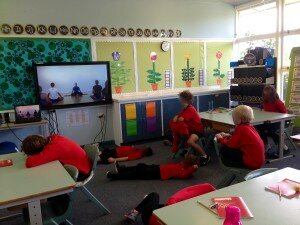
Mindfulness, meditation, and “enjoying the moment” seem to be catch phrases at the moment. Colouring books are wildly popular, all the celebrities meditate daily, and mindfulness is part of everyday conversations. And in this instance, I think the hype is right. You see, I realized not long ago how fast and busy my classroom was. I even wrote a post about trying to slow things down for kids. My heart was in the right place, and the decorations were cool, but I still hadn’t quite grasped what I needed to do. I was so focused on movement. Knowing that children, and young children in particular, need to move, I was jumping, almost frantically, from “challenging academic activity” to “play a game and jump around.” We bounced from working to bouncing, back to working, and back to bouncing! No wonder we were all tired and overwhelmed!
YES, kids need movement. But they ALSO need stillness, quiet, and the chance to turn off. This is supremely lacking for today’s children – heck, today’s HUMANS.
So this year I have implemented a daily meditation session, followed by journal writing. In Grade 3/4 I was hopeful that I could set up a relatively “adult-like” meditation environment. Here were the steps I took:
I made a sign informing any visitors (anyone knocking on our classroom door) that we are unavailable during meditation. This takes place for us for the fifteen to twenty minutes immediately following lunch recess. The sign helps, but I also asked my colleagues to help preserve this time for us at a staff meeting by not sending anyone knocking at that time.
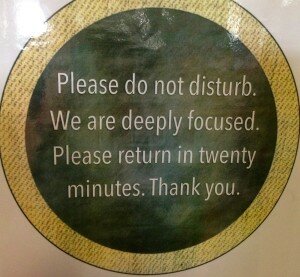
I assigned one student the class job of setting up our meditation. They put up our sign and also move our compost bin, regular trash can, and recycling bin out into the hallway. Because recycling and composting happen after lunch these were common disruptions. I wanted to avoid as many disturbances as possible, so I figured if we left everything outside the classroom then the rest of the school could go on ticking while we stopped for a while.
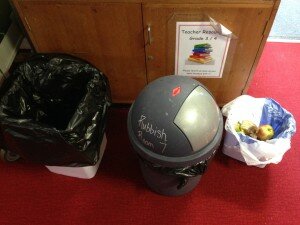
I purchased small notebooks for each of my students to use as journals. The idea here was that the children would all engage in a meditation session for five to ten minutes, followed by five to ten minutes of journalling. I made it very clear that the journal writing was for them, not me. I do EXPECT them to write (not colour, fiddle, talk, etc) during that time. However, they can write about anything they like. A la “Freedom Writers” I invite the kids to turn in their journals if they have written something they want me to read (and respond to.) If they want to keep their words totally private, they can. I simply ask them to date their entries so I know where to begin if they decide to turn their journal in. (I promised to never look earlier in their books.) This absolutely blew the kids’ minds. I had lots of questions from them about this privacy. “How will you know what to read?” “Can I swear in my journal?” (That was a popular one.) I stressed that it is an issue of trust. I made them a promise, and I hoped they would trust me. I said if they swore in their book and gave it to me to read, I would know about it. But if they swore in their book and chose to keep it quiet, I would never know. This POWER given to the kids was really a big deal. (more to follow)
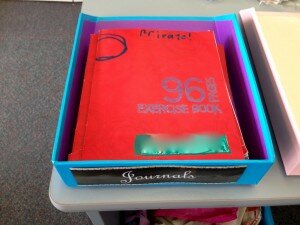
I gathered a few resources for meditations. I wanted to lend credibility to our meditations. While I felt that I could lead or guide a meditation, I wanted the kids to experience different types of meditations and see different people running them. First I showed them a few youtube videos from Deepak Chopra who was discussing the benefits of meditation for kids.
https://www.youtube.com/watch?v=caPDjzw2Fnc
https://www.youtube.com/watch?v=k8GpTO_sU5U
I registered with gonoodle.com, which is a great, free website with lots of movement activities for kids. My students LOVE it! We do lots of Go Noodle activities, but during meditation we stick to the calming category.
I also got an account with yogaglo.com I actually did this personally after a recommendation from a friend, as I was seeking a yoga practise I could do at home. It is paid site, but you can register for a free trial to check it out. Once I began using the site I realised it could serve me at school too. You can search for all types of activities (yoga or meditation.) There are a variety of teachers, and you can select a session by length (I often choose five or ten minute videos for my class.) I liked using this for some meditation for beginners tutorials, and also to have some male instructors.
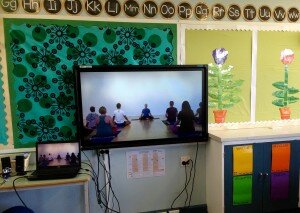
My boisterous kids definitely prefer Go Noodle, but by using a balance of both tools I am reaching them all. If we do a Go Noodle session (which is usually two minutes or less) I also set a timer for an additional four or five minutes of silence, which I talk them through.
Before a meditation session I have the kids spread out. They can lay on their sides or backs (not stomachs, as they end up propping themselves up and can’t relax). They can’t lay under furniture. They can sit in a chair, on the floor, or on a stool. They just can’t be too close to anyone else. I often have to move kids around a bit at first, but many of my kids have discovered a favourite position already.

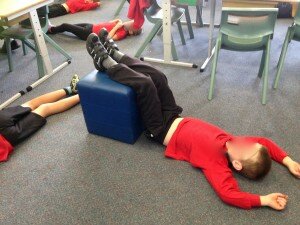
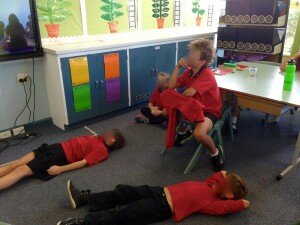
The main goals for us are:
Find stillness. This is super hard for all of us! We tend to wriggle and move, even ever so slightly, almost all the time. The idea is to find a comfortable position and resist the urge to move, even if just to scratch an itch. This is empowering, as you learn that you can breathe through sensations, and you are in control of yourself.
Let go of doing, and just BE for a while. I often say to my kids during meditation, “You don’t have to do. You don’t have to think. You just have to BE. Do nothing right now.” They almost never hear that, and it is liberating.
Gain some head space. The real work of meditation is to NOT think about anything in particular. You are encouraged to notice your thoughts and let them go. This is hard! But when you can, you can really clear your head.
After our meditation session I give the kids five to ten minutes to write in their journals. They can then turn them in, or not, and we go back to our “regular” day’s activities.
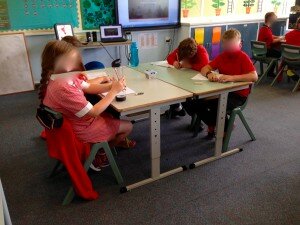
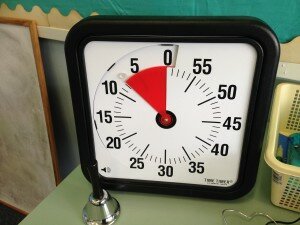
I found, within TWO days, that I had discovered the most important work I think I have ever done in the classroom. At first a few kids turned in their journals. Now I get a stack every day. I write back to every child, every day. This conversation is HUGELY important to them. And it looks different with each child. Some just want me to see their work. I write “cool!” or give them a smiley face, and they are happy. Others tell me about their day or their plans. Again, one sentence, a quick question, or “Sounds like fun!” is all I write. At times I share my own experience to connect with them, if it relates to what they wrote. And some kids pour their hearts out. I had kids telling me about friendship issues, concerns over things they had heard or seen, and concerns about academics. They were literally asking for help in a variety of ways. I now keep my own journal with notes on any issues that I think need to be addressed. Then I can be sure to check in with the child the next day in another way. A lunch time chat or a quick talk in the hallway can suffice. The fact that they know that I am reading, listening, and taking the time to write back has built relationships faster than anything else I have ever done.
Responding to journals usually takes only ten minutes a day. Because the kids only write for five or ten minutes they can’t get that much down on paper. So I don’t have to read or respond to a novel, just a short paragraph.
Some kids enjoy the meditation sessions, other not so much. Sometimes it is not the ones that we expect. Some days I can meditate with them, and others I need to “police” talking and moving around. But we are getting better, we are learning, and we are slowing down. For real. And I wouldn’t trade that for anything!
What do you think about meditation with kids? How do you slow things down for your students?

I began meditating with my k kids…. It’s great! I’m also using the scholastic book, The minds up curriculum, it’s fantastic. The kids learn about their brain and the need to breathe before reacting!
I will certainly look for that book. One thing I want to add is the science behind why we’re doing what we’re doing.
So funny but they just had a segment on Minds up on the Today show…. Check it out!
Hello, What a great use of mindfulness and yoga in your classroom! You should check out amaZEN U! The site (launching tomorrow!) streams yoga and mindfulness activities into any PreK-12 classroom through short, web-based video exercises.
The site is easy to use: Choose an outcome. Decide how you want the class to feel – calm and focused, balanced or energized. Then play the videos at any time of the day, based on what students need. Since teachers note their classroom grade level and desired outcome first, amaZEN U is the only web-based tool that serves teachers what they need without the hassle of filtering through hundreds of videos.
Sign up today at amazenu.com and receive a free trial!
Thanks for that! I will definitely check it out.